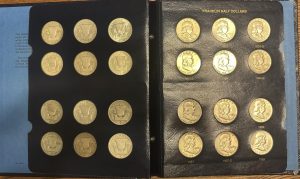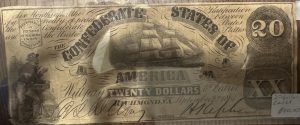Hobbies are usually associated with tremendous money spending and consumption, the likes of which are usually only appealing to determined amateurs or fans of a specific field. Coin collecting is a unique exception, where instead of spending money on things that only have value if a market for them exists, you invest into precious metals that only increase in value over time. Such a unique and beneficial hobby has attracted a small following at North Penn, and one of the most passionate collectors is senior Dominik DiSanto.
“I began [coin collecting] in February of this year and it all skyrocketed from there. I always was into coins, and I liked having them, even when I was a young child, I used to have a box of foreign coins,” DiSanto stated
DiSanto enjoys coin collecting for multiple reasons, but one of the most important aspects of coin collecting to him is Numismatic Art. Numismatics is the art and depictions on different payment media and currencies, and by collecting old and unused Numismatic pieces, one can uncover the hidden beauty of coin design and own a piece of history.

“When you buy a bunch of silver coins just for the collecting purposes, then technically you’re buying bullion (pure silver metal), but I don’t do that, I buy specifically for the numismatic art of it,” DiSanto explained.
The currency that we own today could become valuable pieces of history in a couple of decades, either because the city mint mark doesn’t exist anymore, or a signature on a dollar bill is no longer used. One of the most interesting examples of a slight change on a coin increasing its rarity is a silver dollar minted in Carson City, Nevada.
“For a time, Carson City had a mint mark. That [silver dollar coin] is one of those coins, but it only existed from I think 1878 to 1894. Any coin from Carson CIty that you get, you’re gonna at least spend $300 for it,” DiSanto stated.
The material that coins were made of was important before the abolition of the gold standard as coins were minted from precious metals such as gold or silver, providing them value beyond just mere dollars. The shift from the gold standard drastically changed the way we use currency, and made coins worth what they’re said to be worth.
“A silver dollar, a gold dollar, which is smaller, and a paper dollar. All of those things are worth a dollar, so if a piece of bread in a general store cost a dollar back then, you could pay for that piece of bread in silver, gold or paper. It wasn’t until 1933 when Franklin Delano Roosevelt banned the private ownership of gold when gold prices started going up, and then in 1964, when we officially stopped minting silver coins, the silver prices started to go up,” DiSanto stated.
Coins aren’t the only form of currency that have a fascinating and lengthy history. Paper currency, such as dollar bills, have been through plenty of variations and changes throughout the history of their existence. One of the most important ways to designate a US dollar into different categories are stamps. Red stamps show that the bill is an obligation of the US Treasury, technically meaning that it is a part of national debt and blue stamps are dollars that are backed directly by the Government’s silver deposits.

Some dollar bills have a history of never being circulated or circulated for a short period of time. One of these examples are the emergency bills, which were created in the event of a Japanese invasion of Hawaii during the Second World War; and the North African emergency bill, which was given to American soldiers deployed in North Africa during the war.
“The green stamp, the red stamp, the blue stamp and the gold stamp, the green stamp was just money, you can use it in any transaction, the red stamp was you basically owning a bit of the national debt, the blue stamp means that I could basically go to the bank and get silver coins for the bill, and the gold stamp was the same but for gold,” DiSanto explained.
Currency has been the backbone of human civilization for millenia. With every paper currency or coin that you have, you own a piece of history. You never know what transactions were made with the bill, or who it was given to. With a passion for history and education, DiSanto is already committed to Kutztown University, and plans to major in Secondary Education with a focus in History, and is committed to his career goals of becoming a history teacher at North Penn.



Joe • Nov 17, 2024 at 8:22 pm
The coins depicted in the coin album are not gold dollars. They are 9o% silver Ben Franklin Half dollars.
Enoel • Oct 30, 2024 at 1:43 pm
Hola tengo varias monedas antiguas y deseo venderlas
Hussein • Oct 28, 2024 at 2:54 pm
I have georgives coins can get for me buyers
1ke • Oct 28, 2024 at 10:29 am
I have a small but potent coin collection 2
I have Bills as well
Do u know where some actually collectors are located?
One that like,
if I have a coin of value at the moment, won’t jip me on the value?
Dominik DiSanto • Nov 18, 2024 at 10:02 am
Coins and Currency of Wayne is my go to